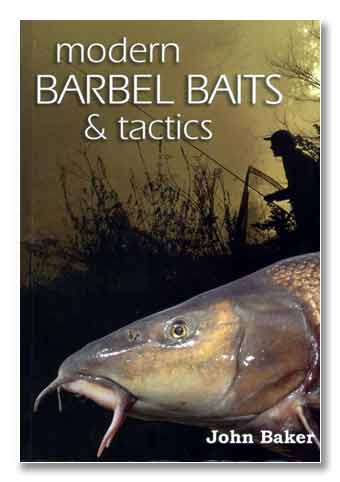Reviewed by David Will
John Baker has been at the forefront of bait making for carp and latterly barbel and tench. His previous work includes the bait section in Kevin Maddock’s ‘Carp Fever’ book and many magazine articles.
His latest offering, entitled ‘Modern Barbel Baits and Tactics’ is a paperback costing a whopping £ 16.95.
 I have not used Mr Baker’s baits for barbel therefore I am not going to go into the undoubted success they have had over the years. I have read this book though and I will give any potential purchasers a view of what they can expect.
I have not used Mr Baker’s baits for barbel therefore I am not going to go into the undoubted success they have had over the years. I have read this book though and I will give any potential purchasers a view of what they can expect.
The book starts by explaining that the traditional baits and methods are in need of updating if continued success is to be found. He goes on to give the other ingredients of success, like a plan and commitment.Confidence in a bait or plan is next, and he tells us how we can achieve this by using new baits on easy rivers to get the ingredient levels right before targeting more difficult waters.
In the next chapter we are asked why we should change. We are told that maggots are expensive and along with luncheon meat they are viewed with suspicion by the barbel. He accepts meat can be dyed or flavoured but it is still meat and the fish know it. Maggots of course are always susceptible to 8oz chub eating them.
What follows in the next few chapters are an overview of JB’s qualifications in bait technology, bait nutrition recognition and the Wilton theory.
The drawbacks and benefits of milk proteins are covered. I found this very confusing. On one hand we are told that milk proteins are expensive, that the use of them needs dedication and self-control, but are then told why ‘Supermilk’ is so good.
There is a curious reference on page 30 which goes as follows ‘ I wonder if the cost of a high protein bait has something to do with the time and trouble the advocates of these baits put into all other aspects of their fishing’. I read this as meaning milk protein baits are not needed except in the minds of those who use them. As I said, I am confused as to why his next chapter advocates such a bait.
The next few chapters will appeal to those who think they need to know why a bait works, if you think you understand enzymes, amino labels, etc, then this is for you. It left me cold.
Next we learn that boilies are ‘aqua dynamic’ or, in layman’s parlance, they do not roll away in the current.
Flavours are discussed and the book explains that you will get the same buzz as that enjoyed by a fly angler when you’re unique bait catches.
Recipes are discussed and recommended ones are given. Some are short term and others are long term baits.
I stand confused again. The short term baits are for those who want action from the off but at the expense of the long term benefits of the bait. My question is, what if another angler on your water uses the attractors you are using in a long term bait in his short term one?
There are pages dedicated to making pastes, boilies and block baits. One set of instructions tell us how to make a bait exactly the same texture as luncheon meat but with no luncheon meat in it. By the way, this is no good for Supermilk as it ruins it, but this is not explained in the book.
The book goes on to cover all you need to know to catch monster barbel on JB’s baits. This includes pre-baiting, location, the creation of safe feeding zones and ambush points. Stuart Morgan details how he fishes and Tony Miles explains how he contacted John Baker after he hit a brick wall during his own bait experimentation. There are also a few pages from those who have had red letter days using the bait, including Martin Bowler and Guy Robb, who gives his top ten points to succeed. Pete Reading adds his opinions too and interestingly he concurs with my thoughts that a maggot and hemp approach is THE one except in high coloured water when new baits will outperform everything else.
So what do I think?
I think £ 16.95 is an outrageous price for a paperback with 127 pages, very few photographs – and a few of those are of eggs!
Having said that, if you are going to use these baits and any other bait firms for the first time you will learn an awful lot. You could of course buy any of the carp books with a decent bait section or just get a free fact sheet from JB himself. Or why not do what Tony Miles, Stuart Morgan, et al, do and ring the man for a recipe and a plan of action. A phone call will be cheaper and in the case of some areas of the book less confusing.
The best chapter for me was to do with publicity and commercialism. Sadly I suspect it will be the one skipped over by the majority.
Available from large Tackle shops, including The Tackle Box Kent and Leslies of Luton, plus all suppliers of John Baker Baits.
ISBN 0-9541668-0-9
Published by John Baker
Price: £ 16.95













